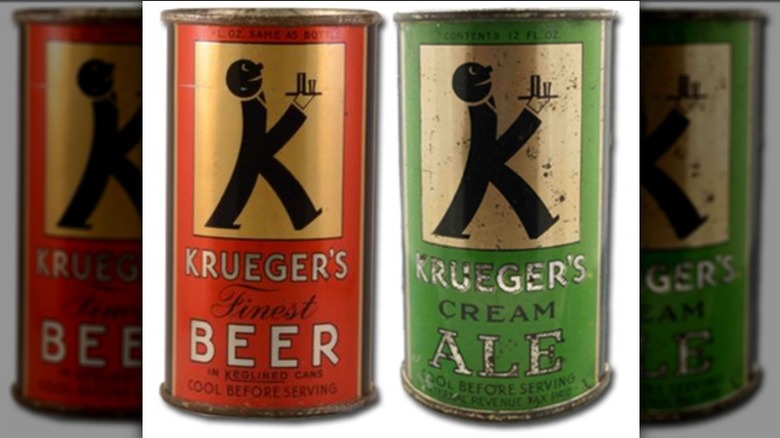The Story Of How Canned Beer Came To Be
By now, beer in a can is so common that most of us don't give it a second thought (except to drink it every day we can). Few of us ponder why and how it is that beer is so frequently served in aluminum cans any more than we wonder why it comes in bottles. But like everything else in the food and beverage world, beer being served in a can has an origin story and an interesting one at that.
Prior to the 20th century, beer in cans was more or less wholly unheard of. Most beer either came in kegs that enabled pubs and bars to pump it into a glass, or was served in bottles. Though it bears mentioning here that even kegs and bottles, or at least the way we think of them now, were themselves relative newcomers in the world of beer. Both came out of the need to keep the beer safely sealed. Crown top bottle caps, which allowed carbonation to be sealed into the bottle, were invented in 1892. The technology for pressurized metal kegs would only become widespread in the early years of the 20th century.
In theory, beer in an airtight can would offer much of the same, but with added benefits. Glass bottles were relatively expensive. And though they were reusable, any returned bottles had to be examined for even the slightest chip or crack, which would render them useless. With breweries shipping their product into wider and wider markets, a more cost-effective method of packaging was needed. So, in 1909, the American Can Company started to experiment with putting beer in cans.
From Prohibition to the Richmond Can Test
American Can's experiments with canned beer were essentially halted by Prohibition. In 1919, after Congress decided that the United States would go dry, selling any kind of beer in any kind of packaging was more or less a legal non-starter. But by the end of the 1920s, brewing giants like Pabst and Anheuser-Busch sensed correctly that the end was nigh for Prohibition and reached out to American Can to restart their experiments with sealed beer cans.
In 1934, the Gottfried Krueger Brewing Company in Newark, New Jersey sent four cans of its Cream Ale and Finest Beer to one thousand homes in the Richmond, Virginia area. The smaller brewing company had been approached by American Can with a proposal. The can company would install the equipment needed to package Krueger beer in cans. If the product failed, Krueger wouldn't have to pay for it. Along with the four thousand cans of beer, questionnaires were sent to the homes in Richmond to gauge whether subjects liked the new packaging method. The results were overwhelmingly positive, and in January 1935, canned beer went on the market. To this day, the Krueger Brewing Company website wears its claim to fame proudly: "First Canned Beer."
Though canned beer would again bow off of the American consumer stage during World War II, it would return again with the war's end. But even then, there were still changes to come in the packaging.
Top this...
The first change to canned beer had to do with the can material itself. Initially, steel was used in the manufacturing of the cans. But in the 1950s, breweries and manufacturers began the switch to aluminum, first just the top for easy opening, then throughout the whole can.
Just as dramatic a change came in the form of the opening method. The first nationally distributed canned beer came not with the familiar tab opening we know today, but with a cone-shaped top, which funneled into a mouth designed for a crown-top bottle cap. This allowed the cheaper metal cans to go through bottling lines just as a glass bottle would without requiring expensive new equipment, and without breweries installing said equipment.
Most drinkers today have never drunk from a cone-top beer can. Nowadays, canned beer almost always comes with a tab for opening on top. These were introduced in 1963 by the Pittsburgh Brewing Company, with Schlitz being the first nationwide brewer to install finger-loop pull tabs on its beer in 1965. The detachable tabs proved so popular that they became the default, even as they would end up littered on the ground in bars and public spaces. In 1975, the Falls City Brewing Company in Louisville, Kentucky introduced the fixed tab, which would stay attached after opening, eliminating the problem of sharp metal being flung all over the place. Even by then, cans had already overtaken bottles as the most popular packaging method for beer. If anything, the convenience of the fixed tabs only added to that popularity and helped turn canned beer into what we recognize today.


